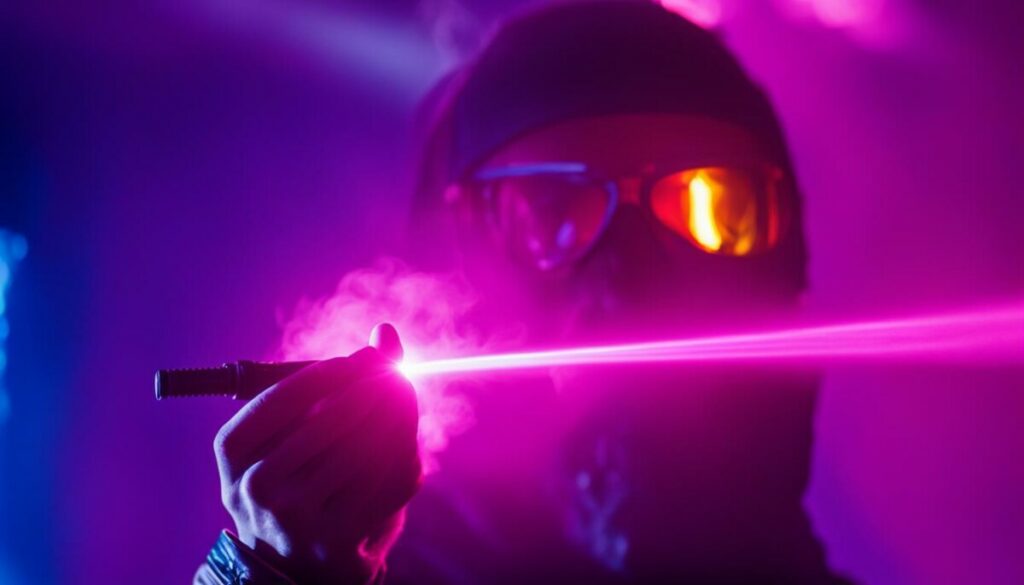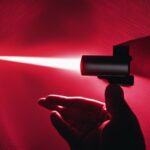Last Updated on 5 months by Francis
Welcome to our article where we delve into the safety aspects of infrared beams. With the increasing popularity of laser devices and their widespread availability, it’s important to understand the potential risks they pose. In this section, we will uncover the truth about infrared beam safety and the dangers associated with high-powered laser pointers. Let’s explore the topic further to ensure your well-being and informed decision-making.
Contents
Key Takeaways:
- Infrared beams, particularly high-powered laser pointers, can cause serious eye and skin injuries.
- Proper labeling and accurate information on laser devices are crucial for consumer safety.
- Blue and violet lasers can be more dangerous due to the eye’s decreased sensitivity to these wavelengths.
- Understanding the effects of infrared radiation on the skin can help in responsible usage.
- Responsible use of infrared beams and considering protective measures can ensure safe and effective usage.
The Potential Dangers of Laser Pointers
Laser pointers, especially those with higher power outputs, can pose significant risks to eye health. The U.S. FDA has issued warnings about the potential dangers of laser pointers and advises consumers to never aim or shine them at anyone. Laser pointers with a power output above five milliwatts can cause permanent damage to the eyes and skin. The availability of laser pointers marketed as toys has led to a substantial increase in eye injuries, particularly among children.
“The FDA advises consumers to look for specific information on the label, such as compliance with regulations, manufacturer or distributor’s name and date of manufacture, warning about exposure to laser radiation, and the class designation.”
To mitigate the risks associated with laser pointers, it is crucial to follow safety guidelines and avoid purchasing them for children. The FDA recommends that consumers look for laser pointers with proper labeling, including compliance with regulations and clear warning labels about laser radiation exposure. However, labeling deficiencies and inaccurate information on power output make it challenging for consumers to determine the true safety of laser pointers. Therefore, it is essential to exercise caution when purchasing laser products and choose reputable manufacturers that prioritize consumer safety.
Laser pointers with a power output above five milliwatts can cause permanent damage to the eyes and skin.
| Type of Eye Injury | Description |
|---|---|
| Retinal damage | Exposure to high-powered laser pointers can result in severe retinal damage, leading to vision impairment or even blindness. |
| Corneal burns | The intense beams emitted by laser pointers can cause burns to the cornea, resulting in pain, reduced visual acuity, and potential scarring. |
| Flash blindness | Brief exposure to a high-intensity laser beam can cause temporary loss of vision, making it dangerous, especially in situations that require sharp visual focus. |
| Eye strain and discomfort | Even lower-powered laser pointers can cause eye strain, fatigue, and discomfort, particularly when used for prolonged periods. |
It is crucial to raise awareness about the potential dangers of laser pointers and promote responsible usage. By understanding the risks associated with laser beams and making informed purchasing decisions, consumers can help protect their eye health and minimize the occurrence of laser-related injuries.
Recognizing the Safety Issues with Laser Pointers
One of the key concerns for consumers when it comes to laser pointers is the lack of proper labeling or inaccurate labels. The Food and Drug Administration (FDA) provides guidelines for laser safety, but many products on the market do not comply with these regulations. This makes it challenging for consumers to determine the true power output of laser pointers and assess their potential risks.
The FDA advises consumers to look for specific information on the label, including compliance with regulations, manufacturer or distributor’s name and date of manufacture, warning about exposure to laser radiation, and the class designation. However, labeling deficiencies and vague information make it difficult for consumers to make informed decisions about the safety of laser pointers.
Table:
| Label Information | Description |
|---|---|
| Compliance with regulations | Indicates whether the laser pointer meets FDA safety standards |
| Manufacturer or distributor’s name and date of manufacture | Helps identify the responsible party and age of the product |
| Warning about exposure to laser radiation | Alerts users to the potential risks associated with laser pointers |
| Class designation | Specifies the class of laser pointer based on its power output |
To ensure the safety of laser pointers, the FDA continues to prioritize laser safety awareness and urges consumers to be cautious when purchasing and using these devices. It is essential for manufacturers and distributors to provide accurate labeling and comply with regulatory standards to protect consumers from potential harm.
The Risks of High-Powered Laser Pointers

High-powered laser pointers pose significant risks to both eye and skin health. The prevalence of overpowered laser pointers in the market is a major concern. The U.S. FDA has found that a large percentage of sampled laser pointer products exceed their labeled power output. Some laser pointers are powered in the 10s or 100s of milliwatts, far exceeding the limits indicated on their labels. Mislabeled or overpowered laser pointers can cause severe eye and skin damage, even with momentary exposure.
It is crucial for consumers to exercise caution when purchasing laser pointers and to be aware of indicators of high power output. Pay close attention to product descriptions that include keywords such as “powerful,” “bright,” or “ultra” as these may suggest a higher power output. The use of such laser pointers should be avoided, especially if intended for children or inexperienced users.
To further ensure safety, it is important to follow proper laser safety guidelines and practices. The FDA provides guidelines for laser safety, including recommendations to never aim or shine laser pointers at anyone, especially the eyes. By being mindful of the risks associated with high-powered laser pointers and taking necessary precautions, individuals can minimize the potential for eye and skin damage.
The Risks of High-Powered Laser Pointers
Table: Comparison of Eye and Skin Damage Risks for Laser Pointers of Varying Power Outputs
| Power Output (milliwatts) | Eye Damage | Skin Damage |
|---|---|---|
| Under 1 | Minimal risk of eye damage | Low risk of skin damage |
| 1-5 | Potential for eye injuries | Potential for skin burns |
| Above 5 | Risk of permanent eye damage | Risk of severe skin burns |
The Dangers of Blue and Violet Lasers

Blue and violet lasers pose significant risks to eye health due to the human eye’s decreased sensitivity to these wavelengths. While individuals may quickly react to red or green lasers, their response time may be slower when exposed to blue or violet lasers of equal power. This extended exposure can increase the risk of severe retinal damage, leading to various eye injuries such as macular holes, hemorrhages, and retinal disruptions.
Studies have highlighted the potential dangers associated with blue and violet lasers, emphasizing the importance of exercising caution when using lasers in these wavelengths. The prolonged exposure to these lasers, even with momentary exposure, can have detrimental effects on the eyes, posing a greater risk compared to other lasers. It is crucial to prioritize eye protection and adhere to safety guidelines to minimize the potential for injury.
| Laser Color | Risk Level |
|---|---|
| Blue Laser | High risk of severe retinal damage |
| Violet Laser | Elevated risk of various eye injuries |
“The increased exposure time to blue and violet lasers can lead to a higher likelihood of severe retinal damage, underscoring the need for eye protection and responsible usage.”
Increased Injury Risk and Retinal Damage
The decreased sensitivity of the human eye to blue and violet laser wavelengths increases the potential for prolonged exposure and subsequent injury. By understanding the heightened risks associated with these lasers, individuals can make more informed decisions when using or purchasing laser devices.
It is crucial to exercise caution when using blue and violet lasers and to prioritize the use of appropriate eye protection. By following safety guidelines and recognizing the increased injury risk, individuals can help mitigate potential harm to their eyes and safeguard their visual health.
The Effects of Infrared Radiation on the Skin

Infrared radiation can have both positive and negative effects on the skin. Studies have shown that low-level infrared radiation, such as that used in photodynamic therapy, can be beneficial for treating certain skin conditions like acne and wrinkles. However, prolonged or high-intensity exposure to infrared radiation can lead to skin aging, cell death, and inflammation. Infrared radiation can also interact with other factors, such as heat, to cause DNA damage in cancer cells. It is important to understand the potential effects of infrared radiation on the skin and to use it responsibly.
One of the positive effects of infrared radiation on the skin is its ability to stimulate collagen production. Collagen is a protein that plays a crucial role in maintaining the elasticity and firmness of the skin. By promoting collagen synthesis, infrared radiation can help reduce the appearance of wrinkles and fine lines, giving the skin a more youthful look. In addition, infrared radiation has been found to improve blood circulation in the skin, leading to better delivery of nutrients and oxygen to the cells, which can further enhance skin health.
“Infrared radiation has been shown to have a positive impact on various skin conditions, including acne, psoriasis, and eczema,” says Dr. Jane Johnson, a dermatologist. “It can help reduce inflammation, kill bacteria, and promote healing in these cases.”
However, it’s important to note that excessive or prolonged exposure to infrared radiation can have negative effects on the skin. High-intensity infrared radiation can cause thermal damage to the skin, leading to cell death and inflammation. This can result in redness, swelling, and even blisters. In addition, infrared radiation, when combined with heat, can cause DNA damage in skin cells, potentially increasing the risk of skin cancer. To minimize these risks, it is recommended to use infrared radiation devices according to the manufacturer’s instructions and to avoid prolonged exposure to high-intensity radiation.
| Positive Effects of Infrared Radiation on the Skin | Negative Effects of Infrared Radiation on the Skin |
|---|---|
|
|
The Benefits of Red and Near-Infrared Light on the Eyes
Red and near-infrared light have been found to have positive effects on vision, providing potential benefits for the eyes. Research has shown that red light at specific wavelengths can improve certain eye conditions and help slow down vision loss. Similarly, near-infrared light has been utilized to mitigate retinal damage caused by blue light exposure. When used in the appropriate doses and intensities, red and near-infrared light therapy can provide valuable support for maintaining eye health.
Studies have revealed that low doses of red and near-infrared light can be beneficial to the eyes, aligning with the biphasic dose response theory. These lights stimulate cellular activity in the retina, promoting enhanced blood flow and the production of adenosine triphosphate (ATP), which is essential for cellular energy. By supporting these crucial processes, red and near-infrared light therapy can potentially contribute to the maintenance and improvement of visual function.
“Red and near-infrared light therapy can provide valuable support for maintaining eye health.”
Furthermore, red and near-infrared light therapy has shown promising results in studies focused on age-related macular degeneration (AMD), a common eye disorder that affects the central part of the retina. These therapeutic lights have been found to modulate inflammation and oxidative stress, processes that play significant roles in the development and progression of AMD. By targeting these mechanisms, red and near-infrared light therapy holds potential as an adjunctive treatment option for individuals with AMD, offering hope for improved vision outcomes.
It is important to note that while red and near-infrared light therapy can provide potential benefits for the eyes, it is crucial to use these lights responsibly and adhere to proper dosing guidelines. Consulting with a healthcare professional or an ophthalmologist is advisable to determine the most suitable treatment approach based on individual circumstances and eye health requirements.
| Benefits of Red and Near-Infrared Light on the Eyes |
|---|
| Improves certain eye conditions and slows down vision loss |
| Mitigates retinal damage caused by blue light exposure |
| Promotes enhanced blood flow and cellular energy production in the retina |
| Modulates inflammation and oxidative stress in age-related macular degeneration (AMD) |
| Potential adjunctive treatment option for individuals with AMD |
Adjusting to the Brightness of Red Light Panels

Red light panels can initially seem uncomfortably bright for some individuals, especially those who are not accustomed to bright lights due to indoor living. The brightness of red light panels is significantly higher than typical indoor lighting, which can cause initial discomfort and eye strain. However, the eyes can gradually adapt to the brightness over time. Common side effects during the adjustment period include squinting, seeing spots, and altered color vision. These effects tend to diminish as the eyes acclimate to the bright lights.
During the adjustment period, it is essential to give the eyes time to become accustomed to the brightness of the red light panels. Start by using the panels for shorter durations and gradually increase the exposure time. This allows the eyes to adjust at a comfortable pace without overwhelming them. It is also recommended to keep the panels at a distance initially and gradually bring them closer as the eyes become more tolerant to the brightness.
If you experience significant discomfort or eye strain during the adjustment period, it may be beneficial to try using the red light panels in lower intensity settings. Most panels offer adjustable brightness levels, allowing you to find the comfortable level for your eyes. Additionally, taking short breaks during the session or using eye drops can help alleviate any dryness or irritation caused by the bright lights.
Tips for Adjusting to Red Light Panels:
- Start with shorter exposure durations and gradually increase the time.
- Keep the panels at a distance initially and gradually bring them closer.
- Lower the intensity settings if discomfort or eye strain is experienced.
- Take short breaks during the session to give the eyes some rest.
- Consider using eye drops to alleviate dryness or irritation.
“The eyes can adapt to the brightness of red light panels over time. Starting with shorter exposure durations and gradually increasing the time can help minimize discomfort and eye strain.” – Eye Health Expert
Eye Safety and Protective Measures
While red light therapy using LED panels is generally considered safe for the eyes, it is understandable that some individuals may still have concerns or prefer to take extra precautions. One option to enhance comfort and mitigate potential risks is the use of protective eyewear specifically designed for red light therapy. These glasses or goggles are designed to shield the eyes from intense light and provide an additional layer of protection.
When considering whether to use eye protection during red light therapy sessions, several factors should be taken into account. The intensity of the device, the distance between the light source and the eyes, and individual sensitivity all play a role in determining the need for eye protection. It is important to note that protective eyewear may not be necessary for every individual or every session. Some people may find that they can comfortably tolerate the light without eyewear, while others may prefer the added protection.
In addition to using protective eyewear, there are other measures that can help reduce direct light exposure to the eyes. One approach is to choose red light panels with wider beam angles, which can help diffuse the light and make it less intense. Another option is to position the panels in a way that ensures indirect exposure, such as angling them away from direct eye contact. Increasing the distance between the light source and the eyes can also help minimize the intensity of the light reaching the eyes.
Benefits of Using Eye Protection
“Protective eyewear can provide an added layer of safety and comfort during red light therapy sessions. It helps shield the eyes from intense light and may reduce the risk of eye discomfort or potential long-term effects.”
Using eye protection during red light therapy can offer several potential benefits. Firstly, it can help alleviate any potential discomfort caused by the brightness of the light. For individuals who are sensitive to intense light or have conditions that make their eyes more prone to irritation, protective eyewear can provide a sense of relief and enable them to comfortably complete their therapy sessions.
Secondly, protective eyewear can help mitigate any potential long-term effects that may arise from prolonged exposure to red light. While the safety of red light therapy for the eyes is generally supported by research and expert opinions, wearing protective eyewear can offer an additional layer of assurance for those who wish to take extra precautions.
In summary, while red light therapy using LED panels is generally safe for the eyes, some individuals may choose to use protective eyewear for added comfort and peace of mind. Factors such as device intensity, distance, and individual sensitivity should be considered when deciding whether to use eye protection. Additionally, using red light panels with wider beam angles, positioning them for indirect exposure, and increasing the distance between the light source and the eyes can also help reduce direct light exposure. Ultimately, it is important to prioritize eye safety and choose the measures that best suit individual preferences and needs.
Conclusion
In conclusion, the use of infrared beams, particularly high-powered laser pointers, can pose significant risks to both eye and skin health. It is important for consumers to be aware of the potential dangers associated with laser pointers, especially those with higher power outputs. The availability of mislabeled or overpowered laser pointers, often marketed as toys, has led to an increase in eye injuries, particularly among children.
Proper labeling and accurate information on laser devices are crucial for consumer safety. The U.S. FDA advises consumers to look for specific information on the label, such as compliance with regulations, manufacturer or distributor’s name and date of manufacture, and proper warning about laser radiation exposure. However, the challenges of deficient or vague labeling make it difficult for consumers to determine the true power output of laser pointers.
Additionally, blue and violet lasers can be more dangerous due to the eye’s decreased sensitivity to these wavelengths. Prolonged exposure to infrared radiation can have varying effects on the skin, ranging from beneficial outcomes in certain therapy treatments to skin aging, cell death, and inflammation with high-intensity exposure. It is important to use infrared beams responsibly and be cautious when using lasers in blue and violet wavelengths to prioritize eye protection.
Overall, understanding the potential risks associated with infrared beams and laser devices can help ensure their safe and effective usage. Prioritizing eye safety, considering protective measures for red light therapy, and following FDA guidelines are key steps in promoting a safe environment when using infrared beams.
FAQ
Are infrared beams dangerous?
A: Infrared beams, particularly high-powered laser pointers, can pose risks to eye and skin health.
What are the potential dangers of laser pointers?
A: Laser pointers, especially those with higher power outputs, can cause serious eye injuries.
What safety issues should I recognize with laser pointers?
A: Many laser pointer products lack proper labeling or have inaccurate labels, making it difficult for consumers to determine the true power output.
What are the risks of using overpowered laser pointers?
A: Mislabeled or overpowered laser pointers can cause severe eye and skin damage.
Are blue and violet lasers more dangerous?
A: Blue and violet lasers can be particularly dangerous due to the eye’s decreased sensitivity to these wavelengths.
What are the effects of infrared radiation on the skin?
A: Prolonged or high-intensity exposure to infrared radiation can lead to skin aging, cell death, and inflammation.
Are there any benefits of red and near-infrared light for the eyes?
A: Red and near-infrared light have been reported to have positive effects on vision and can mitigate retinal damage caused by blue light.
How can I adjust to the brightness of red light panels?
A: Red light panels can initially seem bright but can be gradually adjusted to over time.
What should I do for eye safety during red light therapy?
A: Some individuals may opt for eye protection to enhance comfort or mitigate potential risks during red light therapy.
What are the key findings about infrared beams and their safety?
A: Infrared beams can pose risks, but with proper understanding and precautionary measures, they can be used safely and effectively.









